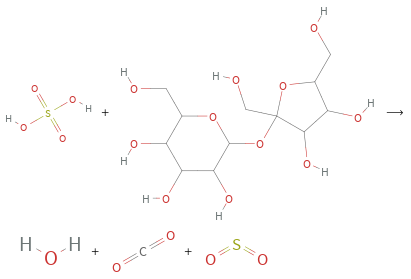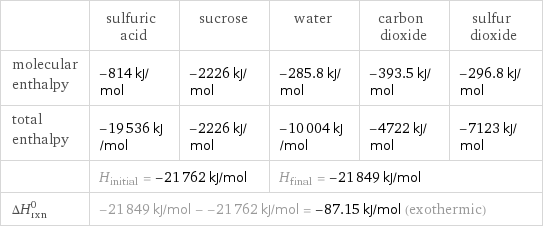Input interpretation

H_2SO_4 sulfuric acid + C_12H_22O_11 sucrose ⟶ H_2O water + CO_2 carbon dioxide + SO_2 sulfur dioxide
Balanced equation

Balance the chemical equation algebraically: H_2SO_4 + C_12H_22O_11 ⟶ H_2O + CO_2 + SO_2 Add stoichiometric coefficients, c_i, to the reactants and products: c_1 H_2SO_4 + c_2 C_12H_22O_11 ⟶ c_3 H_2O + c_4 CO_2 + c_5 SO_2 Set the number of atoms in the reactants equal to the number of atoms in the products for H, O, S and C: H: | 2 c_1 + 22 c_2 = 2 c_3 O: | 4 c_1 + 11 c_2 = c_3 + 2 c_4 + 2 c_5 S: | c_1 = c_5 C: | 12 c_2 = c_4 Since the coefficients are relative quantities and underdetermined, choose a coefficient to set arbitrarily. To keep the coefficients small, the arbitrary value is ordinarily one. For instance, set c_2 = 1 and solve the system of equations for the remaining coefficients: c_1 = 24 c_2 = 1 c_3 = 35 c_4 = 12 c_5 = 24 Substitute the coefficients into the chemical reaction to obtain the balanced equation: Answer: | | 24 H_2SO_4 + C_12H_22O_11 ⟶ 35 H_2O + 12 CO_2 + 24 SO_2
Structures

+ ⟶ + +
Names

sulfuric acid + sucrose ⟶ water + carbon dioxide + sulfur dioxide
Reaction thermodynamics
Enthalpy

| sulfuric acid | sucrose | water | carbon dioxide | sulfur dioxide molecular enthalpy | -814 kJ/mol | -2226 kJ/mol | -285.8 kJ/mol | -393.5 kJ/mol | -296.8 kJ/mol total enthalpy | -19536 kJ/mol | -2226 kJ/mol | -10004 kJ/mol | -4722 kJ/mol | -7123 kJ/mol | H_initial = -21762 kJ/mol | | H_final = -21849 kJ/mol | | ΔH_rxn^0 | -21849 kJ/mol - -21762 kJ/mol = -87.15 kJ/mol (exothermic) | | | |
Equilibrium constant
![Construct the equilibrium constant, K, expression for: H_2SO_4 + C_12H_22O_11 ⟶ H_2O + CO_2 + SO_2 Plan: • Balance the chemical equation. • Determine the stoichiometric numbers. • Assemble the activity expression for each chemical species. • Use the activity expressions to build the equilibrium constant expression. Write the balanced chemical equation: 24 H_2SO_4 + C_12H_22O_11 ⟶ 35 H_2O + 12 CO_2 + 24 SO_2 Assign stoichiometric numbers, ν_i, using the stoichiometric coefficients, c_i, from the balanced chemical equation in the following manner: ν_i = -c_i for reactants and ν_i = c_i for products: chemical species | c_i | ν_i H_2SO_4 | 24 | -24 C_12H_22O_11 | 1 | -1 H_2O | 35 | 35 CO_2 | 12 | 12 SO_2 | 24 | 24 Assemble the activity expressions accounting for the state of matter and ν_i: chemical species | c_i | ν_i | activity expression H_2SO_4 | 24 | -24 | ([H2SO4])^(-24) C_12H_22O_11 | 1 | -1 | ([C12H22O11])^(-1) H_2O | 35 | 35 | ([H2O])^35 CO_2 | 12 | 12 | ([CO2])^12 SO_2 | 24 | 24 | ([SO2])^24 The equilibrium constant symbol in the concentration basis is: K_c Mulitply the activity expressions to arrive at the K_c expression: Answer: | | K_c = ([H2SO4])^(-24) ([C12H22O11])^(-1) ([H2O])^35 ([CO2])^12 ([SO2])^24 = (([H2O])^35 ([CO2])^12 ([SO2])^24)/(([H2SO4])^24 [C12H22O11])](../image_source/09d321810fdc83012a5f2d0c1c2e3576.png)
Construct the equilibrium constant, K, expression for: H_2SO_4 + C_12H_22O_11 ⟶ H_2O + CO_2 + SO_2 Plan: • Balance the chemical equation. • Determine the stoichiometric numbers. • Assemble the activity expression for each chemical species. • Use the activity expressions to build the equilibrium constant expression. Write the balanced chemical equation: 24 H_2SO_4 + C_12H_22O_11 ⟶ 35 H_2O + 12 CO_2 + 24 SO_2 Assign stoichiometric numbers, ν_i, using the stoichiometric coefficients, c_i, from the balanced chemical equation in the following manner: ν_i = -c_i for reactants and ν_i = c_i for products: chemical species | c_i | ν_i H_2SO_4 | 24 | -24 C_12H_22O_11 | 1 | -1 H_2O | 35 | 35 CO_2 | 12 | 12 SO_2 | 24 | 24 Assemble the activity expressions accounting for the state of matter and ν_i: chemical species | c_i | ν_i | activity expression H_2SO_4 | 24 | -24 | ([H2SO4])^(-24) C_12H_22O_11 | 1 | -1 | ([C12H22O11])^(-1) H_2O | 35 | 35 | ([H2O])^35 CO_2 | 12 | 12 | ([CO2])^12 SO_2 | 24 | 24 | ([SO2])^24 The equilibrium constant symbol in the concentration basis is: K_c Mulitply the activity expressions to arrive at the K_c expression: Answer: | | K_c = ([H2SO4])^(-24) ([C12H22O11])^(-1) ([H2O])^35 ([CO2])^12 ([SO2])^24 = (([H2O])^35 ([CO2])^12 ([SO2])^24)/(([H2SO4])^24 [C12H22O11])
Rate of reaction
![Construct the rate of reaction expression for: H_2SO_4 + C_12H_22O_11 ⟶ H_2O + CO_2 + SO_2 Plan: • Balance the chemical equation. • Determine the stoichiometric numbers. • Assemble the rate term for each chemical species. • Write the rate of reaction expression. Write the balanced chemical equation: 24 H_2SO_4 + C_12H_22O_11 ⟶ 35 H_2O + 12 CO_2 + 24 SO_2 Assign stoichiometric numbers, ν_i, using the stoichiometric coefficients, c_i, from the balanced chemical equation in the following manner: ν_i = -c_i for reactants and ν_i = c_i for products: chemical species | c_i | ν_i H_2SO_4 | 24 | -24 C_12H_22O_11 | 1 | -1 H_2O | 35 | 35 CO_2 | 12 | 12 SO_2 | 24 | 24 The rate term for each chemical species, B_i, is 1/ν_i(Δ[B_i])/(Δt) where [B_i] is the amount concentration and t is time: chemical species | c_i | ν_i | rate term H_2SO_4 | 24 | -24 | -1/24 (Δ[H2SO4])/(Δt) C_12H_22O_11 | 1 | -1 | -(Δ[C12H22O11])/(Δt) H_2O | 35 | 35 | 1/35 (Δ[H2O])/(Δt) CO_2 | 12 | 12 | 1/12 (Δ[CO2])/(Δt) SO_2 | 24 | 24 | 1/24 (Δ[SO2])/(Δt) (for infinitesimal rate of change, replace Δ with d) Set the rate terms equal to each other to arrive at the rate expression: Answer: | | rate = -1/24 (Δ[H2SO4])/(Δt) = -(Δ[C12H22O11])/(Δt) = 1/35 (Δ[H2O])/(Δt) = 1/12 (Δ[CO2])/(Δt) = 1/24 (Δ[SO2])/(Δt) (assuming constant volume and no accumulation of intermediates or side products)](../image_source/4f8cf8707b6455fd0102edb7d725bd78.png)
Construct the rate of reaction expression for: H_2SO_4 + C_12H_22O_11 ⟶ H_2O + CO_2 + SO_2 Plan: • Balance the chemical equation. • Determine the stoichiometric numbers. • Assemble the rate term for each chemical species. • Write the rate of reaction expression. Write the balanced chemical equation: 24 H_2SO_4 + C_12H_22O_11 ⟶ 35 H_2O + 12 CO_2 + 24 SO_2 Assign stoichiometric numbers, ν_i, using the stoichiometric coefficients, c_i, from the balanced chemical equation in the following manner: ν_i = -c_i for reactants and ν_i = c_i for products: chemical species | c_i | ν_i H_2SO_4 | 24 | -24 C_12H_22O_11 | 1 | -1 H_2O | 35 | 35 CO_2 | 12 | 12 SO_2 | 24 | 24 The rate term for each chemical species, B_i, is 1/ν_i(Δ[B_i])/(Δt) where [B_i] is the amount concentration and t is time: chemical species | c_i | ν_i | rate term H_2SO_4 | 24 | -24 | -1/24 (Δ[H2SO4])/(Δt) C_12H_22O_11 | 1 | -1 | -(Δ[C12H22O11])/(Δt) H_2O | 35 | 35 | 1/35 (Δ[H2O])/(Δt) CO_2 | 12 | 12 | 1/12 (Δ[CO2])/(Δt) SO_2 | 24 | 24 | 1/24 (Δ[SO2])/(Δt) (for infinitesimal rate of change, replace Δ with d) Set the rate terms equal to each other to arrive at the rate expression: Answer: | | rate = -1/24 (Δ[H2SO4])/(Δt) = -(Δ[C12H22O11])/(Δt) = 1/35 (Δ[H2O])/(Δt) = 1/12 (Δ[CO2])/(Δt) = 1/24 (Δ[SO2])/(Δt) (assuming constant volume and no accumulation of intermediates or side products)
Chemical names and formulas
![| sulfuric acid | sucrose | water | carbon dioxide | sulfur dioxide formula | H_2SO_4 | C_12H_22O_11 | H_2O | CO_2 | SO_2 Hill formula | H_2O_4S | C_12H_22O_11 | H_2O | CO_2 | O_2S name | sulfuric acid | sucrose | water | carbon dioxide | sulfur dioxide IUPAC name | sulfuric acid | (2R, 3S, 4S, 5S, 6R)-2-[(2S, 3S, 4S, 5R)-3, 4-dihydroxy-2, 5-bis(hydroxymethyl)oxolan-2-yl]oxy-6-(hydroxymethyl)oxane-3, 4, 5-triol | water | carbon dioxide | sulfur dioxide](../image_source/c8c76fa5bec4ae64488c7505e033e387.png)
| sulfuric acid | sucrose | water | carbon dioxide | sulfur dioxide formula | H_2SO_4 | C_12H_22O_11 | H_2O | CO_2 | SO_2 Hill formula | H_2O_4S | C_12H_22O_11 | H_2O | CO_2 | O_2S name | sulfuric acid | sucrose | water | carbon dioxide | sulfur dioxide IUPAC name | sulfuric acid | (2R, 3S, 4S, 5S, 6R)-2-[(2S, 3S, 4S, 5R)-3, 4-dihydroxy-2, 5-bis(hydroxymethyl)oxolan-2-yl]oxy-6-(hydroxymethyl)oxane-3, 4, 5-triol | water | carbon dioxide | sulfur dioxide